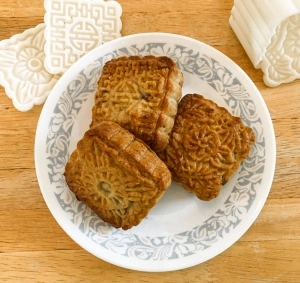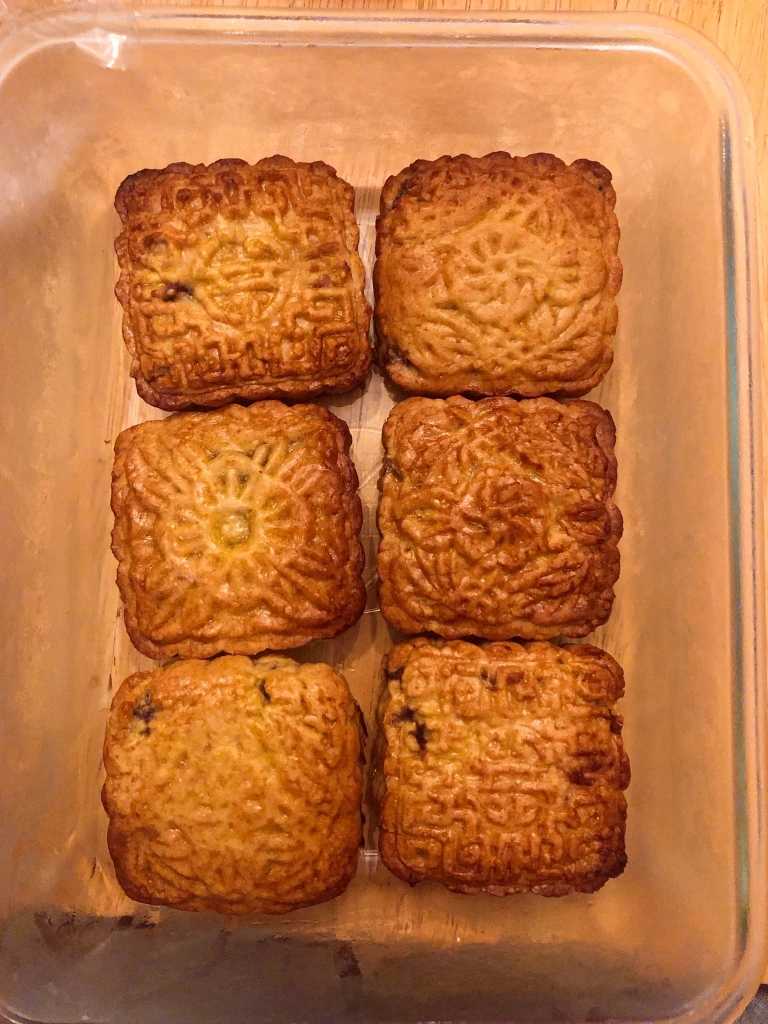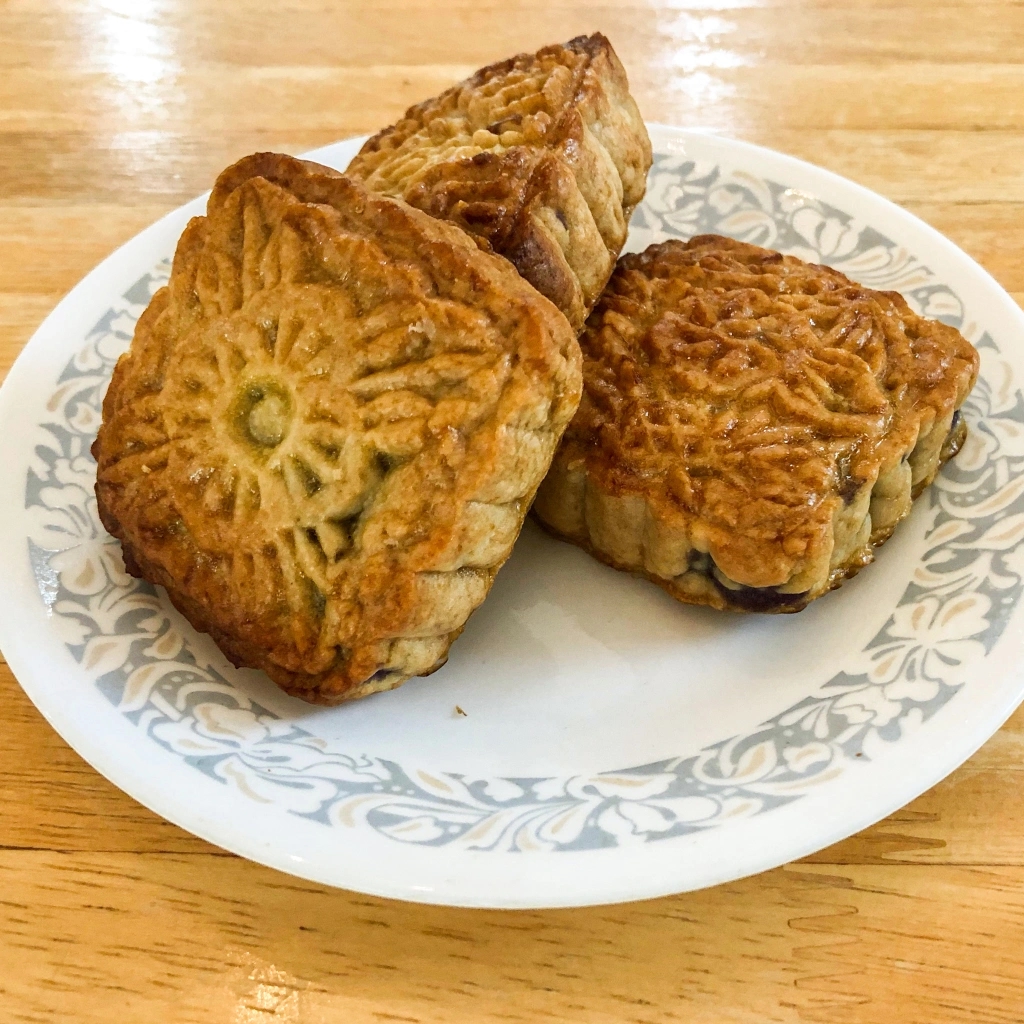Posted on Sep 12, 2024 • 7 minutes • 1305 words

Happy Mid-Autumn Festival!
What is the Mid Autumn Festival? It is a festival celebrating the harvest that typically falls near the autumn equinox. It is based on the lunar calendar, so its exact date varies from September to October. It is most well-known as the Chinese holiday called 中秋节 (zhong qiu jie), but is also celebrated throughout Asia, in Korea (Chuseok), Japan (Tsukimi), and Vietnam (Tet Trung Thu), as well as in parts of Singapore, Indonesia, and Malaysia. The festival’s celebration varies by country, but as Chinese-Americans, my family would always celebrate by enjoying some mooncakes and walking outside to watch the moon.
What Are Mooncakes?
Mooncakes are a symbolic dessert eaten on the Mid Autumn Festival. They are decorated with elaborate stamped designs and characters on top. Traditionally, mooncakes are baked pastries with a rich filling. The pastry layer is akin to a soft cookie, while the filling can be savory or sweet. Traditional fillings include lotus seed paste with salted egg yolk, red bean paste, mixed nutes, and jujube or date paste. However, mooncakes vary by region: variations include Suzhou meat-filled flaky pastry mooncakes and Chaoshan spiral pastry mooncakes. Nowadays, a new style called snowskin, or bing pi (饼皮) has become popular, which has a mochi-like exterior instead of a baked pastry crust. People are also trying many new mooncake fillings, such as custard, green tea, taro, or even durian.
This brings me to my recipe: ube mooncakes. Ube is a purple Phillippine yam similar to a purple sweet potato. It’s naturally sweet, a little bit earthy, and a little bit vanilla-y, and it’s a great filling for mooncakes! Bakery mooncakes can be expensive, and mooncakes are actually pretty simple and fun to make at home, so if you’ve got time, give it a try!

Ingredients
For the mooncake pastry:
- All-purpose flour
- Golden syrup or honey: Traditional mooncakes are made with golden syrup, a type of invert sugar similar to a light molasses. It can be difficult to find in some countries, so I found that swapping the golden syrup for honey works just as well – the dough is just a little bit more crumbly, so be careful measuring flour!
- Neutral oil: Peanut, canola, and vegetable oil are all popular neutral oils. Avoid strongly flavored oils like coconut oil, olive oil, and sesame oil, all of which will impact the flavor in unwanted ways.
- Alkaline (lye) water or baking soda: Lye water is an alkaline solution that, when added to mooncake dough, helps it brown in the oven. Since most people don’t have lye water at home, a good substitute is baking soda mixed with a little bit of water; however, be aware that if you use this substitute, your mooncakes may turn out paler than the photos show.
- Egg wash: For color.
For the filling:
- Ube: You can also use taro root, purple sweet potatoes (or even Japanese sweet potatoes!) if you can’t find ube.
- Coconut milk
- Sugar: Adjust the amount to taste.
You will also need a mooncake stamp if you want your mooncakes to look like traditional bakery ones.
Making Mooncakes
The first thing you’ll do is make the ube paste. This can be done ahead, and it’s pretty hands-off, so don’t get intimidated! You’ll peel, chop, and steam the ube until soft. Mash it into a paste, and cook it over the stove top with some coconut milk and sugar until it’s the desired consistency. Then you can chill it until you need it!
The mooncake dough is super simple: just combine the ingredients in a bowl and knead it lightly until it comes together. Once your dough is finished, divide it into 12 pieces. Each one of these will be the crust for a mooncake!
To make a mooncake, roll out the dough into a thin round. Scoop a few heaping tablespoons of filling into the dough, and wrap the dough securely around the filling. Flour your mooncake mold, and stamp down on the mooncake to form it into shape. Then they’re ready to bake!
Mooncakes are baked twice: once to set the outside, and once more with an egg wash to get that nice color. Don’t worry though – the baking doesn’t take long. Once they’re done, you can enjoy them as is, or let them rest in the refrigerator for one to three days to “age” and get that bakery-soft texture. Of course, if you can’t wait, enjoy them freshly baked! They’ll still be delicious, I promise. 🙂

Tips
- Your dough should not be too crumbly: if it is, you’ve probably added too much flour. You can fix this by adding a bit more oil.
- A common problem making mooncakes is overfilling. If you feel like you can’t fit much filling into your mooncakes, that’s okay! As you get better, you’ll be able to cram more into them, and they’ll look more like the massive ones you see in bakeries (that are like 90% filling, 10% pastry).
- Be sure to flour your mooncake mold well before stamping, especially if your dough is on the sticky side!
- If you don’t have a mooncake stamp, you can actually make free-form mooncakes! Just form the mooncakes as per the instructions, and shape them using your hands instead of using a stamp!
- If you don’t want to use ube filling, you can substitute it for any filling of your choice! I especially like custard, lotus seed paste, and green tea fillings. And feel free to use store-bought filling if you don’t want to make it from scratch!
Ube Mooncakes
A pan-Asian twist on a traditional Mid-Autumn treat!

| Prep Time: 30 min | Cook Time: 20 min |
|---|---|
| Total Time: 50 min | Serves: 12 |
Ingredients
- 2 1/4 cups flour
- 1/2 cup neutral oil, such as canola oil
- 1/2 cup golden syrup or honey
- 1 tsp alkaline lye water or 1/2 tsp baking soda mixed with 1/2 tsp water
- 3 small ube, taro or purple sweet potatoes
- 1/4 – 1/2 cup sugar, to taste
- 1/2 cup coconut milk
- 1 egg
- 2 tbsp water
Instructions |
- Make the filling: Peel and chop the ube into even-sized cubes. Steam in a steamer over high heat for 20-30 minutes or until soft.
- With a fork or in a food processer, process the ube into a mash. Add the sugar and coconut milk.
- Cook in a pan over low heat until it formed a cohesive paste.
- Chill the filling for up to a week or until ready to use.
- Make the dough: In a medium mixing bowl, combine flour, oil, golden syrup/honey, and lye water or baking soda solution. Stir together, kneading lightly, until the dough comes together. Wrap the dough in plastic wrap and chill for 30 minutes.
- Divide the dough into 12 portions.
- Preheat oven to 350 degrees F.
- Form the mooncakes: On a lightly floured surface, roll a portion of dough into a thin round. Roll 3 rounded tablespoons of filling into a ball and place on top of the dough. Wrap the dough securely around the filling and roll lightly to seal.
- Flour your mooncake mold and stamp the mooncake.
- Once all of your mooncakes are stamped, transfer them to a baking sheet and bake for 10 minutes. Beat the egg with water to make an egg wash.
- Pull the mooncakes out of the oven and brush the tops generously with egg wash.
- Lower the oven temperature to 325 degrees F. Return the mooncakes to the oven and bake for an additional 10 minutes, or until they are a rich golden brown.
- Let cool and transfer to fridge to rest for 1-3 days. Or, if you prefer, eat them hot – they’ll be more like a cookie in texture than a mooncake.
- Slice into wedges and serve!
Notes |
I hope you enjoy some mooncakes this Mid Autumn Festival with your family!
This recipe is vegetarian.













